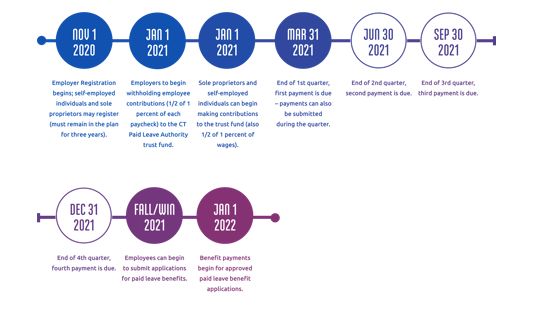Connecticut employers need to start their preparations for the Paid Family and Medical Leave Act (PFMLA), a law that requires all private employers with Connecticut employees to provide paid leave to eligible employees. The Connecticut Paid Leave (CTPL) program, established by the PFMLA, is set to begin in just a few short months. Until then, there are important dates and key steps that employers may want to review to ensure their workplaces are prepared.
Background
On June 25, 2019, the State of Connecticut enacted the PFMLA, which created a comprehensive paid family and medical leave insurance program in Connecticut. The PFMLA requires employers to provide paid leave for reasons covered under the existing Connecticut Family and Medical Leave Act (CTFMLA). In addition to compensating employees on leave, the PFMLA expanded the CTFMLA's definition of "employer" to include all private employers with as few as one employee. The PFMLA likewise expanded the definition of "eligible employee" to cover currently employed employees (i.e., those who have been employed by their employers for at least 12 weeks), eliminated the minimum-hours requirement for eligibility for leave benefits, and broadened the term "family member" to include blood relatives and anyone else whose close association is the equivalent of a family member. The paid leave benefit will be funded by a 0.5 percent mandatory employee payroll tax, which Connecticut employers must begin withholding on January 1, 2021.
Employees who apply for leave under the CTPL program will be compensated on a sliding scale, with lower-paid workers receiving the maximum benefit of up to 95 percent of their regular weekly pay, to be capped at a sum not to exceed 60 times the state minimum wage.
Comparing the New PFMLA to the Existing CTFMLA
| New PFMLA | Existing CTFMLA | |
| Covered employers | All private employers with at least one employee | Private employers with 75 or more employees |
| Eligible employees | Employees are eligible if they have earned wages of at least
$2,325 in the "base period" (which is the first 4 of the
5 most recently completed quarters) and are currently employed or
have been employed within the last 12 weeks.
Wages may include salary or hourly pay, vacation pay, holiday pay, tips, commissions, severance pay, and the cash value of any "in-kind" payments. |
Employee must have worked for the employer for at least 12 months (which do not have to be consecutive) and worked 1,000 hours during the 12 months prior to the leave. |
| Definition of "family member" | Includes:
|
Includes:
|
| Amount of leave | Twelve weeks in a 12-month period with 2 additional weeks available for a pregnancy-related health condition resulting in incapacitation | 16 weeks in a 24-month period |
| Reasons for taking leave | The reasons for leave-which are the same under both
statutes-include:
1. the birth of a child of the employee or placement of a child with the employee for adoption or foster care; 2. the need to care for a family member with a serious health condition; 3. a serious health condition of the employee; 4. service as an organ or bone marrow donor; 5. a qualifying exigency related to the employee's spouse, son, daughter, or parent being on active duty or having been notified of an impending call or order to active duty in the armed forces; or 6. reasons related to family violence. |
|
Administering and Funding the CTPL Program
The CTPL program is administered by the Connecticut (CT) Paid Leave Authority, a newly created quasi-public agency. The CTPL program is 100 percent funded by employees and voluntary self-enrolled participants. Employees will fund the CTPL program by contributing 0.5 percent of their incomes via a mandatory payroll deduction. The PFMLA does not require employers to contribute toward the program. State government employees who belong to unions are also exempt. Employers are responsible for withholding the payroll deductions for each employee and submitting the funds quarterly to the CT Paid Leave Authority. An employer's failure to submit the contributions may result in an assessment of penalties in addition to the required withholdings.
The CT Paid Leave Authority also accepts applications for paid leave benefits, reviews and approves applications, and administers benefits to eligible employees. Employees will need to apply to both their employers for time away from work and to the CT Paid Leave Authority for paid leave benefits. It will likely be necessary for the employee, employer, and the Paid Leave Authority to communicate in order to establish the reason for the leave or to verify the duration and frequency of the leave.
The Connecticut Department of Labor is responsible for hearing grievances related to claims.
Registering With the CT Paid Leave Authority in November 2020
Beginning in November 2020, covered employers will need to register with the CT Paid Leave Authority to establish their accounts. The collection of wage deductions must begin on January 1, 2021. Employers may want to consider communicating with their payroll provider or tax advisor prior to January 1, 2021, to ensure compliance. Employees are eligible to receive benefits beginning January 1, 2022.

Qualifying for an Exemption
Covered employers may apply for an exemption if they intend to offer private plans that provide "all of the same rights, protections, and benefits" to all employees that the CTPL program provides. The CT Paid Leave Authority is currently developing this application process.
In order for an employer to qualify for an exemption from making contributions to the CT Paid Leave Authority, the employer's private plan must:
- "Offer at least the same number of weeks of benefits
- Offer at least the same level of wage replacement for each week of benefits
- Include no additional requirements or conditions
- Deduct the same amount from employee paychecks as the state plan
- Cover all employees through the duration of their employment
- Apply to all current and future employees at your business
- Be approved by a majority of your employees
- Remain compliant with any additional requirements established by the CT Paid Leave Authority"
Although employers may apply for an exemption, individual employees are not permitted to opt out of making mandatory contributions.
An employer approved for the exemption is not required to collect the wage deduction. Instead, the employer may deduct up to 0.5 percent of its employees' wages to fund the private plan, but it is not required to do so.
Communicating With Employees
Starting July 1, 2022, covered employers must provide written notice to eligible employees at the time of hire, and annually thereafter, of their entitlement to the CTPL program. Covered employers must also notify eligible employees that the PFMLA prohibits retaliation for requesting or using paid leave under the CTPL program and inform employees of the right to file a complaint with the Connecticut Department of Labor for violations of the law.
While the statute does not require employers to provide notice until long after contributions begin and benefits become available, employers may want to inform employees prior to withholding the mandatory payroll deduction in January 2021.
Checklist for Compliance
While the benefit provided under the new PFMLA will not occur for another year, employers may want to consider the following preparations in advance of the law's implementation:
- calendaring key dates for PFMLA compliance;
- reviewing Connecticut's current applicable leave policies;
- revising leave policies as needed to clarify to whom leaves apply and when employees must use accrued paid vacation, sick time, or personal time;
- training human resources, managers, supervisors, and other personnel involved in administering leave policies;
- training human resources, managers, supervisors, and other personnel that retaliation against employees utilizing the paid leave benefit is prohibited;
- coordinating with vendors, including payroll companies, that assist in leave law compliance;
- ensuring that processes are in place for employees to receive notice both at the time of hire and annually thereafter of their right to benefits under the law;
- creating a plan to manage leaves of absences, including managing workflow in an employee's absence; and
- determining if offering a private leave plan is appropriate and seeking approval from the CT Paid Leave Authority. Any private leave plan must provide, at a minimum, the same rights, protections, and benefits at the same cost to the employee as provided under the law and meet a number of other specific requirements, including approval by a majority vote of the employer's employees.
Connecticut businesses may want to monitor the new law as many of the law's provisions begin to take effect. There will likely be additional public information, guidance, regulatory developments, and clarifications as the program launches.
Originally published by Ogletree Deakins, October 2020
The content of this article is intended to provide a general guide to the subject matter. Specialist advice should be sought about your specific circumstances.



